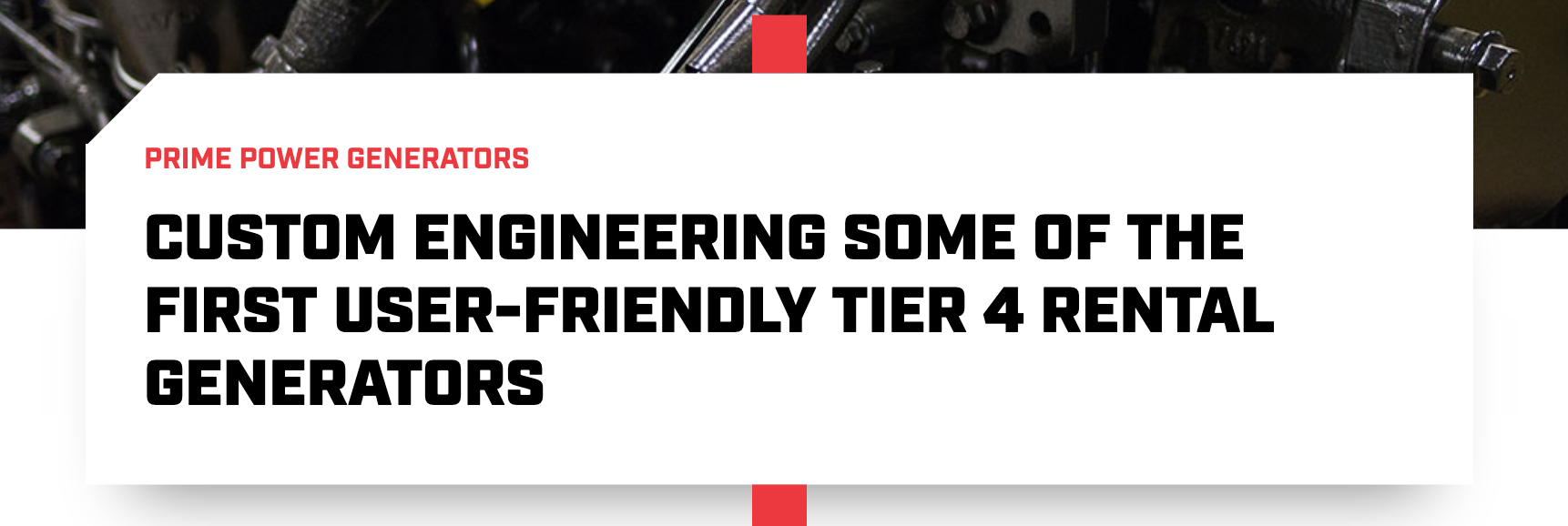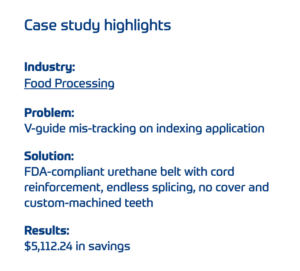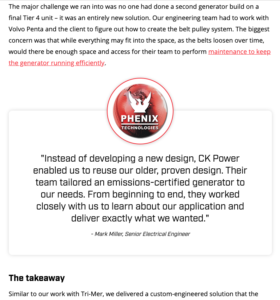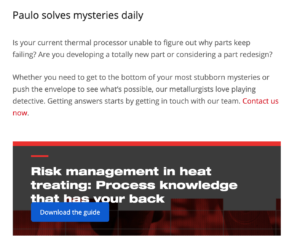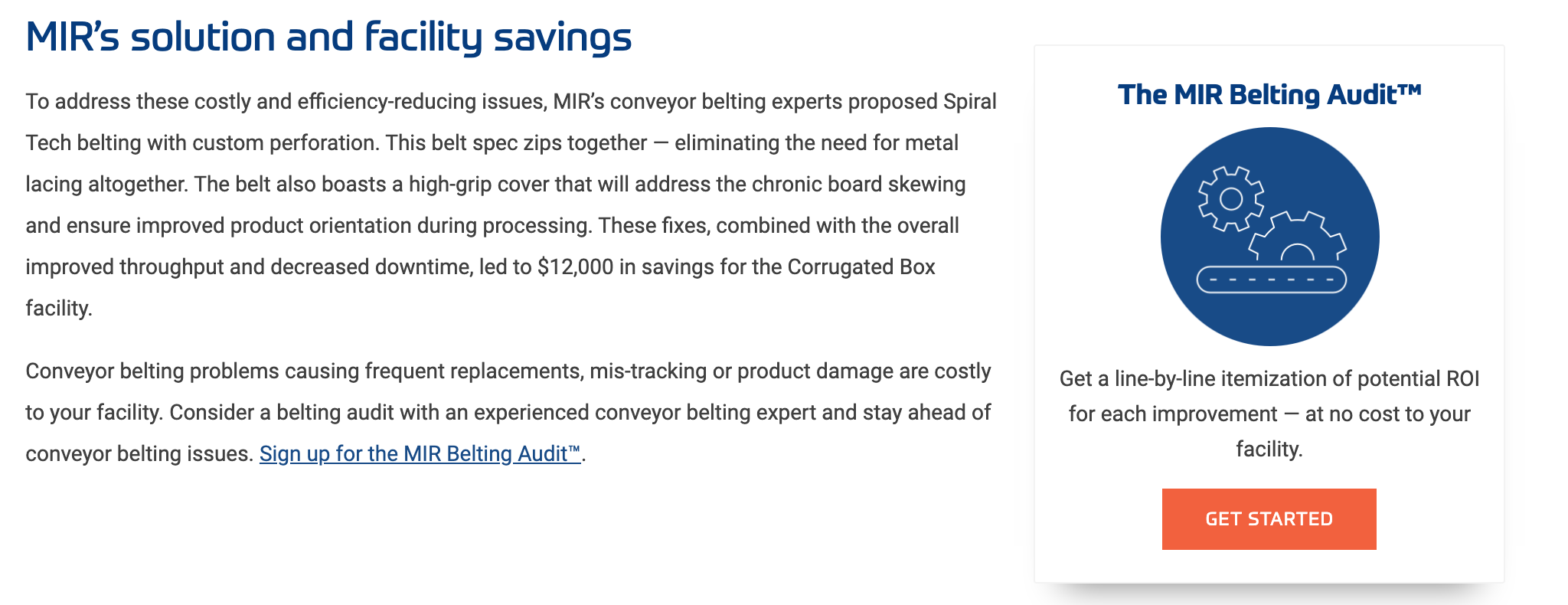How to write the perfect customer success story

We’ve already established what makes the perfect home page and the perfect B2B knowledge center. Another tool in your industrial marketing toolbox that’s worth perfecting? Well thought-out, customer-driven case studies that will demonstrate to potential customers you’re right for the job.
You’re likely already familiar with publishing case studies — hey, who doesn’t want to talk about the success of their past projects? But today we’ll focus on the elements that will take your case study from a run-of-the-mill regurgitation of project details to a compelling piece of content that will leave potential customers saying, “Wow, I want them to do that for me!”
Let’s get started.
Selecting a project for a case study
Before we dive into the elements that make up a perfect case study, let’s take a moment to discuss project selection. Just picking a random or most recent project from the top of the pile isn’t going to cut it. When evaluating a project, consider these questions:
- Is this the type of work we want to complete in the future?
- Is there a distinctive problem we solved or a unique solution to discuss?
- Is there enough information to create a substantial piece of content?
If you answer these questions with a resounding “Yes!” this will be a great project to highlight. If not, go back to the drawing board and select another project from the vault.
The elements of a perfect B2B case study
To visually represent what we like to see on a B2B manufacturer’s case study pages, here’s a wireframe (or page blueprint) of the ideal case study:

Now let’s dive in.
The intriguing headline and image
Simply put, a quality case study headline will engage your reader’s attention as he scrolls through your site or reads from your email newsletter.

How to catch their eye with the headline? There are two things I like to keep in mind: 1. Utilize impressive stats or statements and 2. Highlight what the customer got out of the project (as opposed to what you accomplished).
Read this first draft of a case study headline from a conveyor belt provider focusing on what the B2B manufacturer accomplished:
Now compare it with this option highlighting what the customer gained from the project:
If I’m searching for a belting partner for my facility, I know which one I’m going to read.
You may encounter case studies in which a specific dollar amount, percentage or other statistic isn’t feasible to include with the project. But just because your headline doesn’t include a flashy figure doesn’t mean you can’t still achieve engaging specificity.
For instance, in this case study from an engine and generator manufacturer and distributor, their team engineered generators that were some of the first of their kind.
Not necessarily a statistic, but still an impressive characteristic of the case study with the greatest chance of catching reader’s eye.
To help get the gears turning for your case study headline, here’s a formula I like to use:
How a [insert brief solution descriptor] led to [insert result, either a figure or high-level improvement] at a [insert customer business descriptor]
It may not work in every case study you publish, but it’s a good jumping off point for brainstorming headlines that will encourage visitors to read further.
In addition to the headline, project images are a simple way to represent your project visually and snag the attention of the reader. It also can help her quickly filter through case studies that relate to the type of project she hopes to complete. For example, check out this case study overview page from a geotechnical contractor:
Here, potential customers can easily pick a case study showcasing services that fit their needs, whether that’s university construction project or renovations to public service buildings. Include a high-quality image from the project (or for projects where security measures prohibit sharing actual images from the job, stock photos come in handy) and you’re one step closer to engaging the reader with your content.
The executive summary
This part is pretty straightforward: Simply summarize the major takeaways from the body copy into easily scannable bullet points. Why is this important? It allows for an easy point of entry for those who may not read the whole piece, but can still get the gist of the case study (and still get blown away by your work).
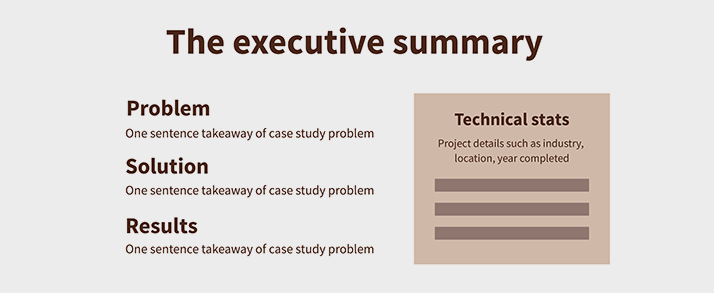
The executive summary should include the problem, solution and results at minimum (more on those later). It’s also best to write the executive summary last, pulling out key points is easier once the full body copy is complete.
Here’s an example of an executive summary from a conveyor belt provider case study.
Also, if it’s relevant for your line of work, a section with technical stats can provide more quick takeaways. The contents of the “case study facts” or “project details” section will vary from manufacturer to manufacturer, but consider including information such as:
- Industry or market.
- Company name or description.
- Services provided.
- Location.
- Year completed.
- Basic stats of project (square footage, material conveyed, product engineered).
If you decide not to employ an executive summary, use clear subheads through the body copy to ensure the content is scannable.
The problem
Now getting into the bulk of the case study, start out by describing the problem (soon to be followed by the solution and the results). This naturally creates a narrative arc with a sense of conclusion for the reader and facilitates the organization of a wide swath of details into a more comprehensible format.

When you describe the problem, don’t just explain what was wrong; set the stakes for the reader. What was at risk for the customer if a solution wasn’t found? Did they stand to weaken customer relationships, decrease throughput, jeopardize safety qualifications? This is also an excellent place to “set the scene” and provide context for the project. Include demographics of the customer’s company, scope and stages of the project, and other environmental / contextual descriptors. Even better, include visual elements from the project such as:
- Images taken at the work site.
- More technical photos — such as these screenshots of the microstructure of automotive components — to help visualize complex topics.
- Technical drawings, charts, graphs or reports from the project.
- Video footage of the project, such as this drone footage of a ground improvement project.
And images aren’t only for the problem section — use them throughout the body copy to help visualize each stage of the project. These facilitate a complete understanding of the work you accomplished.
The solution
In the solution section, clearly describe how you completed the job. Include as many details as you can, from material selection to team members involved to installation process — the whole nine yards.
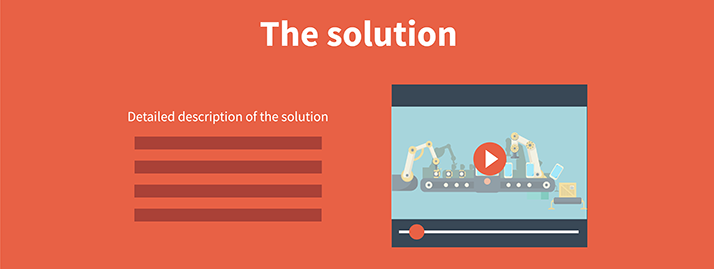
With our case studies, we think of these both as a chance to demonstrate expertise and function as a persuasive piece of content. When a potential customer finishes reading your case study, they should not only understand the nuts and bolts of what you did; they should feel like they got a peek into your thought processes and problem-solving capabilities — and want to replicate that experience for themselves.
You should also talk through any unique or innovative aspects of your work. The reader may not know that hauling 80,000 pounds of generator equipment down the highway is actually an extraordinary feat — explain that to us!
If there were any challenges or roadblocks your team encountered during the project, mention those as well. Periods of trial and error — such as this conveyor belt provider’s multiple rounds of belt testing for an X-ray belt — showcase a problem-solving mindset and give readers a taste of your consultative abilities.
The results
This is arguably the most important section for a potential customer. Any statistics, percentages, dollar amounts that you can share here, do it. And don’t forget to talk about the soft benefits as well: Time saved for management, increased sense of customer safety, a streamlined manufacturing process. Showcase the invaluable nature of your solution for this particular customer.

For the results section (as well as the problem and solution sections), don’t feel like you’re tied to a particular word count. As we like to say in our writing department, “Make it as long as it needs to be.” That may seem cryptic, but it’s really about understanding the core purpose of a case study, which is to explain a project in detail to a potential customer. If that mean an 1,100-word odyssey on how metallurgists used subtly different process temperatures to improve automotive component performance, do it. If it only takes you 300 words to describe your solution, that’s great, too. This prevents you from adding unnecessary “fluff” to bulk up the case study or cutting essential details to get under a certain word count. Tell the story you need to tell and an appropriate length will follow suit.
Also, across the entire case study, be sure to employ specific, descriptive language. This doesn’t mean peppering in empty adjectives — no “cutting-edge solution” or “ecstatic customer” usage, please. Instead, rely on verifiable details — “a heating solution that led to a 22°F increase in natural gas temperature and reduced hydrate formation” or “a customer with fewer stress test failures and ultimately lowered manufacturing costs.” Instead of relying on lazy, easy adjectives, this pushes you to be specific about your project — and helps the work resonate with potential customers.
Our final recommendation is to have a team member from outside the project look over the body copy. This is a great chance to catch any jargon that might have slipped in and ensure the problem, solution and results are clear.
The compelling customer testimonial
Discussing the work you completed on a project clearly demonstrates expertise — but it carries even more weight coming from the recipient of the services. You can still have a robust case study without a customer testimonial, but this element adds an extra “oomph” and only strengthens your case as a provider of quality services.
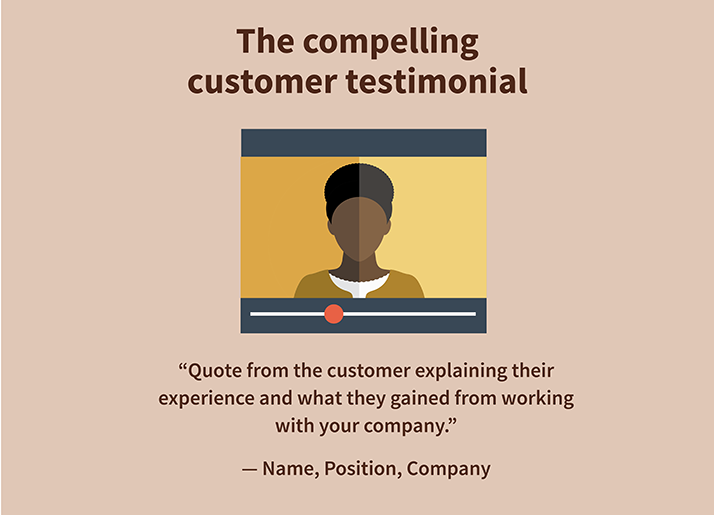
Customer input can come in many formats, depending on the level of involvement you can get from your client. Quotes (like this one from an engine and generator manufacturer and distributor’s case study), are fairly easy to come by from a quick phone call or email.
A full-on customer testimonial — essentially a longer version of a customer quote where they detail the experience from their perspective — gives your customer a bigger platform from which to share their story. Finally, a video interview will involve greater time investment on both ends, but the immediacy and resonance of their story in video format is invaluable. Plus, you now have a great asset to use within the case study, throughout your website and in future outreach campaigns.
The call to action
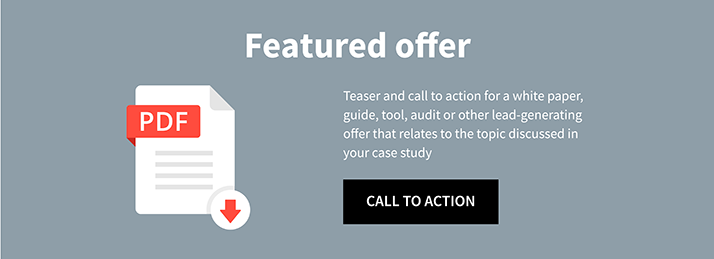
You’ve given your reader ample insight into your engineering process and showcased impressive results — now put a bow on it and tell him how to take the next step.
For case studies, a tried-and-true CTA is a downloadable gated asset related to the topic you covered in the case study, such as the example above where a guide to risk management in heat treating follows a case study involving unconventional heat treatment. Other options include an offer for a consultation (like this conveyor belting provider’s offer for a facility audit) or something as simple as a newsletter signup.
This CTA allows you to convert a case study reader into a lead and engage with the potential customers reading your case studies.
You’re ready to start
By reading this article, you’re already one step closer to creating the perfect case study — and repeating that process to build a library of impressive past projects. All you need to do now is pick a project and start writing.


